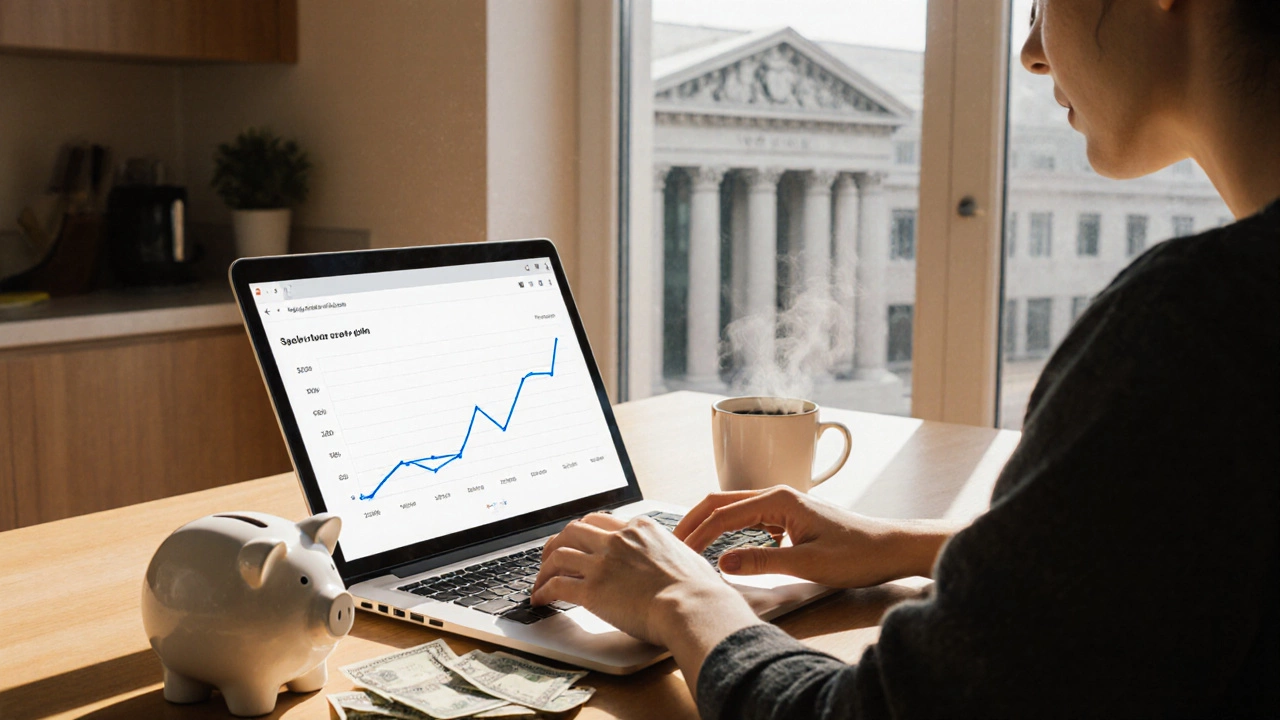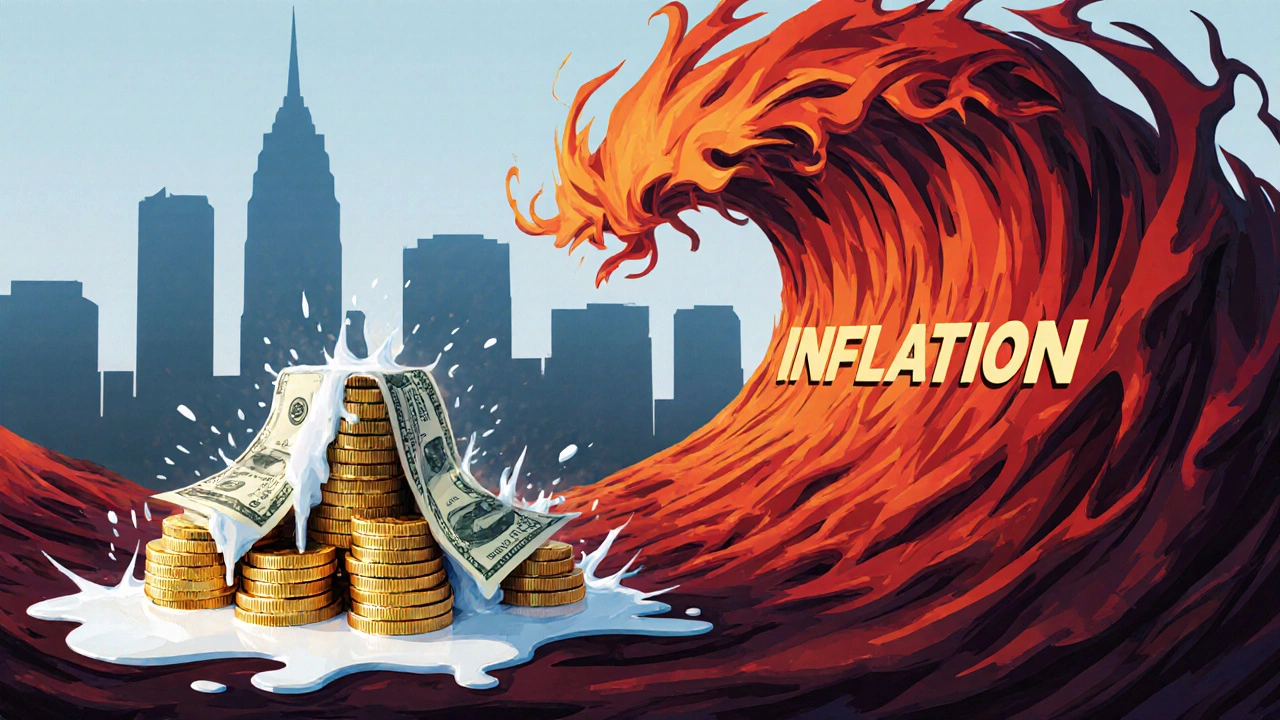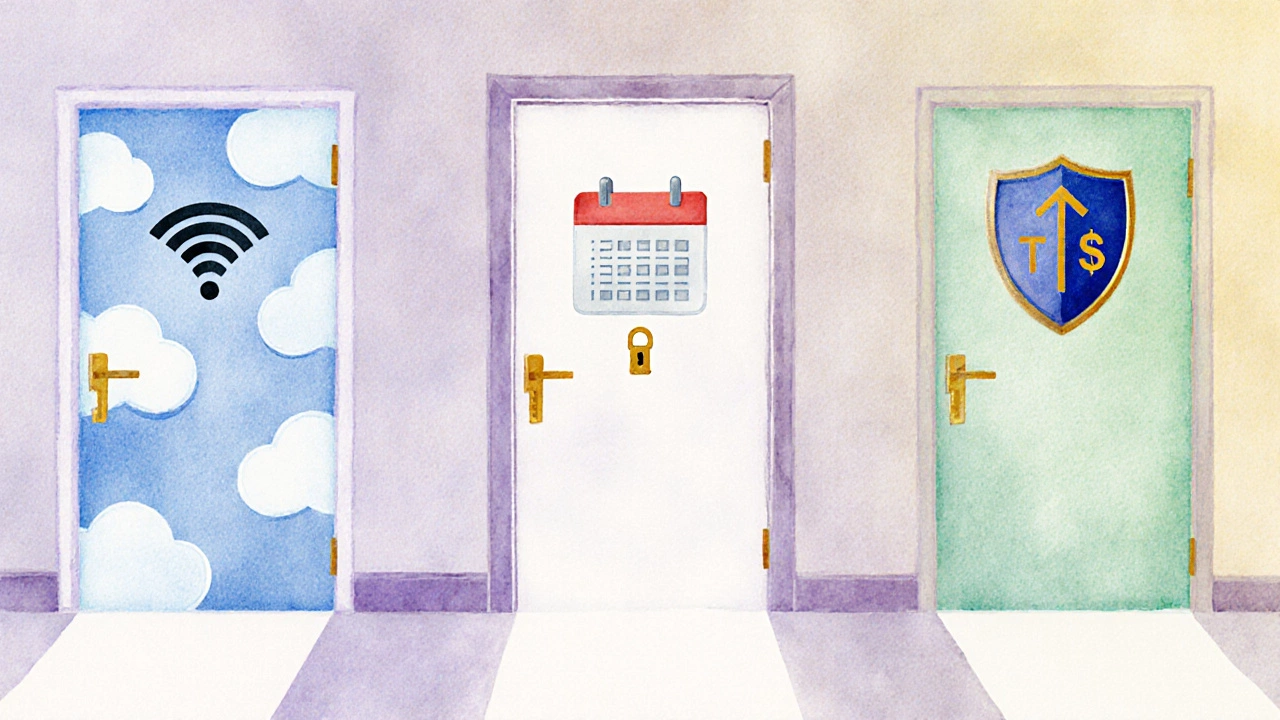Saving Money in a Savings Account: Risks and Benefits
 Oct, 21 2025
Oct, 21 2025
Inflation-Adjusted Savings Calculator
Calculate Your Real Return
Understand how inflation affects your savings growth.
What This Means
Your real return is calculated as: Interest Rate - Inflation Rate. When your real return is negative, your money's purchasing power is shrinking even if your account balance grows.
According to the article: "If your account earns 0.55% while inflation runs at 3%, your real return is negative – you're effectively losing money."
Compare Savings Options
Which account type is best for your goals?
| Account Type | Typical APY (2025) | Real Return Potential | Best For |
|---|---|---|---|
| Standard Savings Account | 0.55% | -2.75% (if inflation=3.3%) | Emergency funds & short-term goals |
| High-Yield Savings | 4.20% | +0.90% (if inflation=3.3%) | Medium-term savings with better rates |
| Certificate of Deposit | 5.00% | +1.70% (if inflation=3.3%) | Fixed-term savings with higher rates |
| Money Market Account | 3.80% | +0.50% (if inflation=3.3%) | Short-term needs with check-writing |
| TIPS (Treasury Inflation-Protected) | Varies (inflation-linked) | Preserves purchasing power | Long-term protection against inflation |
Source: The article's comparison table shows how different options balance interest rates, liquidity, and inflation protection.
When you hear "savings account", you probably picture a safe spot for cash that earns a tiny bit of interest. But is that really the best place for your money, especially when rates are low and prices keep climbing? Let’s break down what a Savings account is a deposit account offered by banks and credit unions that pays interest on the balance while allowing easy withdrawals actually does, what hidden costs you might be missing, and when you should look at other options.
How a Savings Account Generates Earnings
Most banks calculate interest daily and credit it monthly. The math is simple: balance × interest rate ÷ 365 × days held. Some institutions add the effect of Compound interest the process where earned interest is added to the principal, so future interest is calculated on a larger amount, which can slightly boost returns over time. In 2025, the average national savings account rate sits around 0.55% APY, while high‑yield online accounts hover near 4.2%.
The Inflation Factor
Inflation erodes purchasing power. Over the past year, Canada’s Consumer Price Index rose 2.8%, and the U.S. saw 3.3% inflation. If your account earns 0.55% while inflation runs at 3%, your real return is negative - you’re effectively losing money. Inflation a general increase in prices and fall in the purchasing value of money is the silent enemy that turns a seemingly safe deposit into a shrinking stash.
When a Savings Account Is Actually Useful
- Emergency fund: You need cash that’s instantly accessible. A traditional savings account provides that liquidity without penalties.
- Short‑term goals (e.g., a vacation or a down‑payment within a year) where preserving capital matters more than growth.
- Keeping a buffer for overdraft protection or automatic bill payments.
In these scenarios, the convenience and FDIC/ CDIC insurance (up to $250,000 per institution) often outweigh the low return.

Hidden Costs and Pitfalls
- Low interest rates: As mentioned, many accounts barely beat inflation.
- Fees: Monthly maintenance fees, excess transaction charges, or low‑balance fees can eat into earnings.
- Limited growth potential: Compared to stocks or bonds, the upside is capped.
- Opportunity cost: Money tied up in a low‑yield account could be invested elsewhere for higher returns.
Better Alternatives for Different Goals
If you’re comfortable with a little less liquidity or a modest risk level, consider these options:
| Product | Typical APY (2025) | Liquidity | Minimum Balance | Insurance |
|---|---|---|---|---|
| Standard Savings Account | 0.55% | Instant | $0‑$100 | FDIC/CDIC up to $250k |
| High‑Yield Savings | 4.20% | 1‑2 days (online transfer) | $0‑$1,000 | FDIC/CDIC up to $250k |
| Certificate of Deposit (CD) | 5.00% (1‑year) | Locked until maturity (early withdrawal penalty) | $500 | FDIC/CDIC up to $250k |
| Money Market Account | 3.80% | Check‑writing & limited withdrawals | $2,500 | FDIC/CDIC up to $250k |
| TIPS (Treasury Inflation‑Protected Securities) | Varies (inflation‑linked) | Sell any time (market risk) | $100 | US Treasury guaranteed |
Each option balances interest, safety, and access differently. High‑yield savings accounts give a solid boost without locking your cash, while CDs lock you in for a set term in exchange for higher rates. Money market accounts sit between the two, often offering check‑writing privileges. If you want guaranteed protection against inflation, TIPS can preserve purchasing power, though they’re more suited for a diversified portfolio.
How to Choose the Right Place for Your Money
- Define your timeline: < 1 year → prioritize liquidity; 1‑5 years → consider CDs or high‑yield accounts; >5 years → think about bonds, TIPS, or equities.
- Assess your risk tolerance: If losing a small portion of interest bothers you, stick with insured accounts.
- Check fee structures: Look for “no‑fee” or “fee‑waived with balance” accounts.
- Compare interest rates regularly. Online banks update rates more often than brick‑and‑mortar ones.
- Factor in inflation expectations: If inflation outlook is high, consider inflation‑linked instruments.

Common Mistakes and How to Avoid Them
Even savvy savers slip up. Here are the most frequent errors and quick fixes:
- Leaving cash in a zero‑interest account: Move it to a high‑yield account the moment you see a better rate.
- Ignoring fees: A $5 monthly fee on a $2,000 balance cuts your effective yield by over 3%.
- Over‑concentrating in one institution: Split funds across a couple of banks to stay under insurance limits and to chase higher rates.
- Not rebalancing: Review your cash allocation every 6‑12 months; what was safe yesterday might be sub‑optimal today.
- Assuming “savings” equals “growth”: If you need growth, allocate a portion to stocks, ETFs, or mutual funds.
Bottom Line: Is It Bad to Leave Money in a Savings Account?
Not inherently. For emergency cash and short‑term needs, a traditional Savings account does the job-fast access, FDIC/CDIC protection, and zero‑risk principal. The problem arises when you let a large portion of your long‑term assets sit there while inflation outpaces returns. In that case, you’re effectively losing purchasing power.
Smart strategy: keep a modest, easily reachable emergency fund in a standard savings account, then park the rest in higher‑yield or inflation‑protected vehicles that match your time horizon and comfort level.
Frequently Asked Questions
Can I have multiple savings accounts at different banks?
Yes. Splitting money across several institutions helps you stay under the $250,000 insurance limit per bank and lets you chase the best rates.
What’s the difference between a high‑yield savings account and a regular one?
High‑yield accounts are usually offered by online banks, pay substantially higher APYs (often 3‑5%), and may require a minimum balance or limit the number of withdrawals per month.
Are the interest rates on savings accounts fixed?
Most are variable and can change month to month based on the bank’s policy and market conditions. Some promotional rates lock for a limited period.
How does inflation‑protected savings differ from a regular savings account?
Inflation‑protected options, like TIPS, adjust the principal based on the Consumer Price Index, so your real purchasing power stays stable. Regular savings accounts do not adjust for inflation.
Should I use a money market account for my emergency fund?
Money market accounts can be a good choice if you want slightly higher rates and still need quick access, but make sure you understand any withdrawal limits and minimum balance requirements.
Is a certificate of deposit (CD) safe for long‑term savings?
CDs are FDIC‑insured and offer higher fixed rates, making them safe. However, because they lock your money, they’re best for goals you won’t need before the maturity date.
